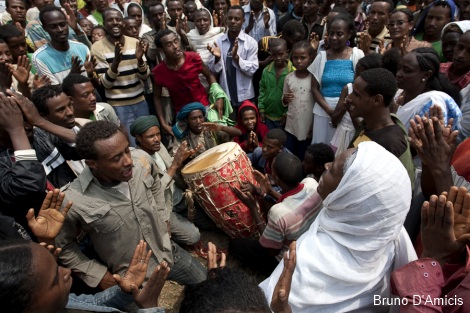EXPLORE » HISTORY & CULTURE » PEOPLE
PEOPLE

The majority of Kafa Biosphere Reserve’s population are Kafecho people with over 80% of the population. Kafa’s people display genuine warmth, hospitality and friendliness, which make visitors feel not only welcomed but also a part of the community.
KAFECHO
The Kafecho people are the most populous group in the Kafa region. Their ancestors were part of the prestigious Kafa Kingdom. Today the majority of the Kafecho are farmers and coffee collectors. The Kafecho speak Kafinoono. The Kafecho mostly practice orthodox Christianity, but some are Muslim.
MANJA
 The Kafa Kingdom’s historical highly inflexible class-system still penetrates society today. The Manja people, part of the lowest class, constitute 5-10% of the total population in the Biosphere Reserve. They have a separate clan system and different facial features than the Kafecho. They occupy the outskirts of settlements considered by other residents to be too susceptible to wild animals. Historically, low-status occupations included gold, silver and black smiths, tanners, potters, weavers, and hunters. The Manja continue a tradition in skilled hunting using traps, nets, and spears. They are also skilled tree climbers and the main suppliers of fire wood and charcoal to Bonga. Manja used to subsist mainly on wild game such as monkeys, porcupines and pigs, however, the government has recently prohibited hunting. Today they mainly rely on agriculture. The Manja have adopted the clans of the farmers on whose land they have settled and are slowly becoming more integrated in society. Manja are considered the indigenous population of the forests of Kafa. They have been overpowered by various ethnic groups, especially the Kafecho during the period of the Kafa Kingdom.
The Kafa Kingdom’s historical highly inflexible class-system still penetrates society today. The Manja people, part of the lowest class, constitute 5-10% of the total population in the Biosphere Reserve. They have a separate clan system and different facial features than the Kafecho. They occupy the outskirts of settlements considered by other residents to be too susceptible to wild animals. Historically, low-status occupations included gold, silver and black smiths, tanners, potters, weavers, and hunters. The Manja continue a tradition in skilled hunting using traps, nets, and spears. They are also skilled tree climbers and the main suppliers of fire wood and charcoal to Bonga. Manja used to subsist mainly on wild game such as monkeys, porcupines and pigs, however, the government has recently prohibited hunting. Today they mainly rely on agriculture. The Manja have adopted the clans of the farmers on whose land they have settled and are slowly becoming more integrated in society. Manja are considered the indigenous population of the forests of Kafa. They have been overpowered by various ethnic groups, especially the Kafecho during the period of the Kafa Kingdom.
AMHARA AND OROMO
 A small group of Amhara and Oromo people reside in Kafa as a result of state initiated resettlement programs and independent migration from hunger stricken areas of Ethiopia to the resource-rich southwestern forests. Amhara people are mainly farmers who practice Christianity. The Oromo group encompasses all tribes that speak a dialect of Afaan Oromo. They differ in religion, lifestyle, and politics from the rest of the population of Kafa.
A small group of Amhara and Oromo people reside in Kafa as a result of state initiated resettlement programs and independent migration from hunger stricken areas of Ethiopia to the resource-rich southwestern forests. Amhara people are mainly farmers who practice Christianity. The Oromo group encompasses all tribes that speak a dialect of Afaan Oromo. They differ in religion, lifestyle, and politics from the rest of the population of Kafa.
LANGUAGES
In Kafa, the majority of the population’s first language is Kafinoono, the language of the Kafecho people. Amharic is the official business and education language in Ethiopia and many people can understand it.
For more information on Kafa’s people please refer to:
Freeman, D. and Pankhurst, A. (2003). Peripheral People: the excluded minorities of Ethiopia. C. Hurst & Co. (Publishers) Ltd.
